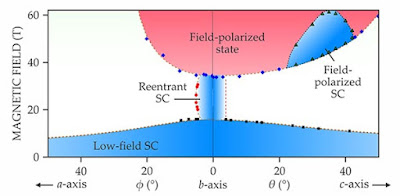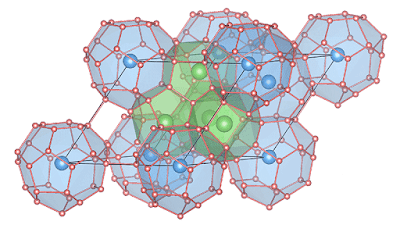Topics: Applied Physics, Civics, Materials Science, Solid-State Physics, Superconductors
I'm a person who will get Nature on my home email, my previous graduate school email (that's active because it's also on my phone), and my work email. Because it said "physics," I was primed to read it.
What I read made me clasp my hands over my mouth, and periodically stared at the ceiling tiles. My forehead bumped the desk softly, symbolically in disbelief.
Ranga Dias, the physicist at the center of the room-temperature superconductivity scandal, committed data fabrication, falsification and plagiarism, according to a investigation commissioned by his university. Nature’s news team discovered the bombshell investigation report in court documents.
The 10-month investigation, which concluded on 8 February, was carried out by an independent group of scientists recruited by the University of Rochester in New York. They examined 16 allegations against Dias and concluded that it was more likely than not that in each case, the physicist had committed scientific misconduct. The university is now attempting to fire Dias, who is a tenure-track faculty member at Rochester, before his contract expires at the end of the 2024–25 academic year.
Exclusive: official investigation reveals how superconductivity physicist faked blockbuster results
The confidential 124-page report from the University of Rochester, disclosed in a lawsuit, details the extent of Ranga Dias’s scientific misconduct. By Dan Garisto, Nature.
In a nutshell, this is the Scientific Method and how it relates to this investigation:
1. Ask a Question. It can be as simple as "Why is that the way it is?" The question suggests observation, as in, the researcher has read, or seen something in the lab that piqued their curiosity. It is also known as the problem the researcher hopes to solve. The problem must be clear, concise, and testable, i.e., a designed experiment is possible, a survey to gather data can be crafted.
2. Research (n): "the systematic investigation into and study of materials and sources in order to establish facts and reach new conclusions" (Oxford languages). Here, you are "looking for the gaps" in knowledge. People are human, and due to the times and the technology available, something else about a subject may reveal itself through careful examination. The topic area is researched through credible sources, bibliographies, similar published research, textbooks from subject matter experts. Google Scholar counts; grainy YouTube videos don't.
3. The Hypothesis. This encapsulates your research in the form of an idea that can be tested by observation, or experiment. The null hypothesis is a statement or claim that the researcher makes they are trying to disprove, and the alternate hypothesis is a statement or claim the researcher makes they are trying to prove, and with sufficient evidence, disproves the null hypothesis.
4. Design an Experiment. Design of experiments (DOE) follows a set pattern, usually from statistics, or now, using software packages to evaluate input variables, and judging their relationship to output variables. If it sounds like y = f(x), it is.
5. Data Analysis. "The process of systematically applying statistical and/or logical techniques to describe and illustrate, condense and recap, and evaluate data." Source: Responsible Conduct of Research, Northern Illinois University. This succinct definition is the source of my faceplanting regarding this Nature article.
6. Conclusion. R-squared relates to the data gathered, also called the coefficient of determination. Back to the y = f(x) analogy, r-squared is the fit of the data between the independent variables (x) and the output variables (y). An r-squared of 0.90, or 90% and higher, is considered a "good fit" of the data, and the experimenter can make predictions from their results. Did the experimenter disprove the null hypothesis or prove the alternate hypothesis? Were both disproved? (That's called "starting over.")
7. Communication. You craft your results in a journal publication, hopefully one with a high impact factor. If your research helps others in their research ("looking for gaps"), you start seeing yourself appearing in "related research" and "citation" emails from Google Scholar. Your mailbox will fill up, as I hope your self-esteem.
Back to the faceplant:
The 124-page investigation report is a stunning account of Dias’s deceit across the two Nature papers, as well as two other now-retracted papers — one in Chemical Communications3 and one in Physical Review Letters (PRL)4. In the two Nature papers, Dias claimed to have discovered room-temperature superconductivity — zero electrical resistance at ambient temperatures — first in a compound made of carbon, sulfur and hydrogen (CSH)1 and then in a compound eventually found to be made of lutetium and hydrogen (LuH)2.
Capping years of allegations and analyses, the report methodically documents how Dias deliberately misled his co-authors, journal editors and the scientific community. A university spokesperson described the investigation as “a fair and thorough process,” which reached the correct conclusion.
When asked to surrender raw data, Dias gave "massaged" data.
"In several instances, the investigation found, Dias intentionally misled his team members and collaborators about the origins of data. Through interviews, the investigators worked out that Dias had told his partners at UNLV that measurements were taken at Rochester, but had told researchers at Rochester that they were taken at UNLV."
Dias also lied to journals. In the case of the retracted PRL paper4 — which was about the electrical properties of manganese disulfide (MnS2) — the journal conducted its own investigation and concluded that there was apparent fabrication and “a deliberate attempt to obstruct the investigation” by providing reviewers with manipulated data rather than raw data. The investigators commissioned by Rochester confirmed the journal’s findings that Dias had taken electrical resistance data on germanium tetraselenide from his own PhD thesis and passed these data off as coming from MnS2 — a completely different material with different properties (see ‘Odd similarity’). When questioned about this by the investigators, Dias sent them the same manipulated data that was sent to PRL.

Winners and losers
Winners - Scientific Integrity.
The investigators of Nature were trying to preserve the reputation of physics and the rigor of peer review. Any results from any experiment has to be replicable in similar conditions in other laboratories. Usually, when retractions are ordered, it is because that didn't happen. If I drop tablets of Alka Seltzer in water in Brazil, and do it in Canada, I should still get "plop-plop-fizz-fizz." But the "odd similarity" graphs isn't that. The only differences between the two are 0.5 Gigapascals (109 Pascals, 1 Pascal = 1 Newton/meter squared = 1 N/m2), the materials under test, and the color of the graphs. Face. Plant.
Losers - The Public Trust.
"The establishment of our new government seemed to be the last **great experiment** for promoting human happiness." George Washington, January 9, 1790
As you can probably tell, I admire Carl Sagan and how he tried to popularize science communication. But Dr. Sagan, Bill Nye the Science Guy, the canceled reality series Myth Busters (that I actually LIKED) has not bridged the gap between society's obsession with spectacle, and though the previously mentioned gentlemen and television show were promoting "science as cool," it is still a discipline, it takes work and rigor to master subjects that are not part of casual conversations, nor can you "Google." There are late nights solving problems, early mornings running experiments while everyone else outside of your library or lab window seems to be enjoying college life and what it can offer.
Dr. Dias is as susceptible to Maslow's Hierarchy of Needs (physical, safety, love and belonging, esteem, and self-actualization) as anyone of us. Some humans express this need posting "selfies" or social media posts "going viral," no matter how outrageous, or the collateral damage to the non-cyber real world. Or, they like to see their names in print in journals, filling their inboxes with "related research" or "citation" emails with their names attached. There is even currency now in your research being MENTIONED in social media.
*****
Mr. Halsey was the librarian at Fairview Elementary School in Winston-Salem, North Carolina. Everyone in my fifth grade class had to do a book report, but before we could do that, we had to pass Mr. Halsey's exam - with an 85% or better - on the Dewey Decimal System, and SHOW him in a practicum, that we could find a book that he would give you using Dewey. If you didn't pass, you didn't do the book report, and you failed English. I thankfully made an 92%, and satisfied Mr. Halsey that I wouldn't get lost in the periodicals.
We now have search engines that we can utilize via supercomputers in our hip pockets. A lot of effort to know math, physics, chemistry applied to the manufacture of semiconductors for those supercomputers instead of facilitating access to knowledge might have inadvertently manufactured a generation suffering from Dunning-Kruger. Networking those supercomputers over a worldwide web, coupled with artificial intelligence gives malevolent actors inordinate power over a captive audience of 8 billion souls.
Couple this with the falsification of data having a lease in the realm of science; it only contributes to the mistrust of institutions like the academy, like our democracy, which has been referred to since Washington as "the great experiment." If the null, and the alternate hypotheses are discarded, what pray tell, is on the other side of what we've always known?





